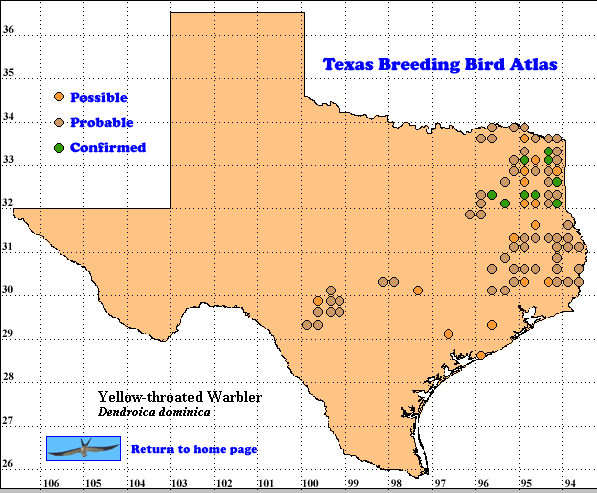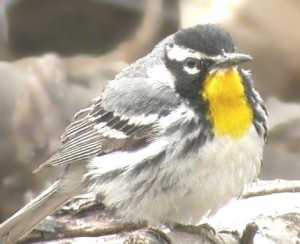Yellow-throated Warblers nest and forage in the tree canopy, making observation of their life history difficult. These warblers feed on small insects and their larvae by probing in bunches of pine needles or on strands of Spanish moss. Their diet includes prey as small as scale insects (Hall 1996).
Populations on the Atlantic and Gulf coasts (west to Louisiana) are resident and have a yellow stripe above the eye, while interior populations (including all birds in Texas) are migratory and have a white eyebrow stripe (Pyle 1997, Lockwood and Freeman 2004).
DISTRIBUTION. During the 1987-1992 field work seasons of the TBBA project, atlasers found 9 confirmed breeding sites in latilongs 32094, 32095 and 33094 in the Pineywoods. The 88 probable and 37 possible records cane from that region, adjacent areas of the Post Oak Savannah and Blackland Prairies, the southern Edwards Plateau and northern Coastal Prairies regions (see the region map in Lockwood and Freeman [2004]). This distribution is similar to that on a North American Breeding Bird Survey (BBS) map using data from 19 routes in Texas. These routes had relative abundances of <3 warblers per route (Sauer et al. 2005). The summer and nesting symbol’s on Oberholser’s 1974 map extend further west and south than the east Texas records on the TBBA map.
Yellow-throated Warblers breed as far north as southern Illinois, Indiana, southern Ohio and southeastern Pennsylvania and as far south as central Florida and the Gulf Coast. In winter these warblers are found along the Atlantic and Gulf coast from South Carolina to Mississippi and throughout Florida. They also winter along the Gulf Coast from central Texas to Honduras, the highlands of southwest and south Mexico and Guatemala and many Caribbean islands (Howell and Webb 1995, Hall 1996, Saueret al. 2005).
SEASONAL OCCURRENCE. Most Yellow- throated Warblers arrive in Texas between mid- March and late April and breed from, late April to mid-July, based on egg dates from May 15-July1. Most southbound migrants are present from late July to late November. In winter this warbler is rare to locally uncommon along the coast and in the lower Rio Grande River valley (Oberholser 1974, Lockwood and Freeman 2004).
BREEDING HABITAT. Yellow-throated Warblers breed in Texas from near sea level to 500 m (1700 ft) in open pine woodlands or bald cypress-American sycamore woodlands along rivers and bayous (Oberholser 1974). In areas with Spanish moss, nests are built in clumps hanging from horizontal branches, usually 9-18 m (30-60 gt) above ground and far from the trunk. The cup-shaped hollow is lined with grasses, forbs, feathers and moss, woven into the cup. Nests in other areas are usually saddled on a horizontal branch and constructed of bark strips, grasses, forb stems, plant down and feathers (Harrison 1979).
After finishing the nest the female usually lays 4 (range 3-5) smooth, generally greenish or grayish white eggs, speckled, spotted or blotched with various shades of red, purple, brown or gray. She incubates the eggs for about 12 days and the young leave the nest about 10 days after hatching. Two broods per season are usual in the southern part of the range. Parasitism by Brown-headed Cowbird (Molothrus ater) is infrequent (Harrison 1979, Hall 1996).
STATUS. Yellow-throated Warbler is an uncommon to locally common summer resident of the eastern third of Texas.. In riparian corridors of the Edwards Plateau, this warbler is uncommon to rare (Lockwood and Freeman 2004). The apparent historical range contraction suggested by comparison between the TBBA map and that in Oberholser (1974) is disturbing as is the BBS trend data for 1980-2005 which suggest an annual population change of -6.2% for Texas. Across the United States and Canada data from 453 routes suggest little population change has occurred over this period (Sauer et al. 2005). Preservation of habitat for this warbler in Texas is obviously critical. Text by Robert C. Tweit (2007)
 Literature cited.
Literature cited.
Hall, G. A. 1996. Yellow-throated Warbler (Dendroica dominica). InThe birds of North America, No. 223 (A. Poole and F. Gill, eds.). The Birds of North America, Inc., Philadelphia, PA.
Harrison, H. H. 1979. A field guide to western birds’ nests. Houghton Mifflin, Boston, MA.
